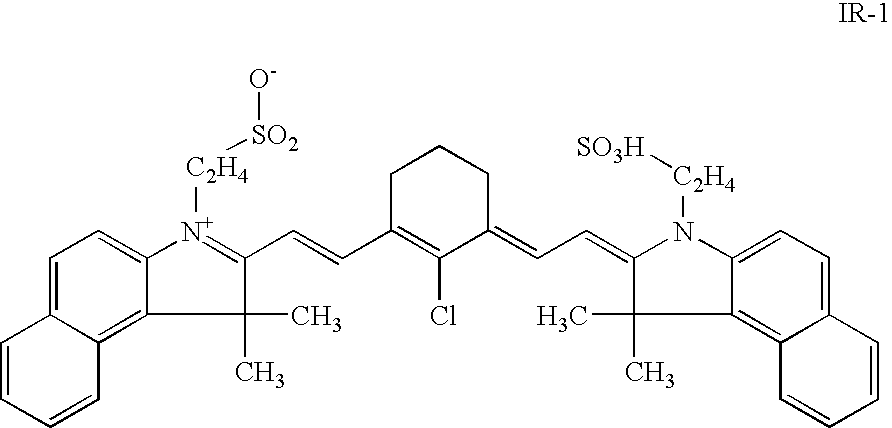Method for making a negative working, heat-sensitive lithographic printing plate precursor
a lithographic printing plate and negative technology, applied in the field of making a negative working lithographic printing plate precursor, can solve the problems of high sensitivity, high run-length during printing, and requires a long exposure time and/or a high power laser, and achieve excellent printing properties, improve run-length on the press, and high sensitivity
- Summary
- Abstract
- Description
- Claims
- Application Information
AI Technical Summary
Benefits of technology
Problems solved by technology
Method used
Image
Examples
example 1
[0057]Preparation of the Lithographic Substrate.
[0058]A 0.30 mm thick aluminum foil was degreased by immersing the foil in an aqueous solution containing 40 g / l of sodium hydroxide at 60° C. for 8 seconds and rinsed with demineralized water for 2 seconds. The foil was then electrochemically grained during 15 seconds using an alternating current in an aqueous solution containing 12 g / l of hydrochloric acid and 38 g / l of aluminum sulfate (18-hydrate) at a temperature of 33° C. and a current density of 130 A / dm2. After rinsing with demineralized water for 2 seconds, the aluminum foil was then desmutted by etching with an aqueous solution containing 155 g / l of sulfuric acid at 70° C. for 4 seconds and rinsed with demineralized water at 25° C. for 2 seconds. The foil was subsequently subjected to anodic oxidation during 13 seconds in an aqueous solution containing 155 g / l of sulfuric acid at a temperature of 45° C. and a current density of 22 A / dm2, then washed with demineralized water f...
example 2
Preparation of the Lithographic Substrate.
[0071]The preparation of the lithographic substrate was done according to Example 1.
[0072]Preparation of the Printing Plate Precursors 7–10.
[0073]The printing plate precursors 7 to 10 were produced by applying a coating onto the above described lithographic substrate. The composition of the coating is defined in Table 3. The average particle sizes of the styrene / acrylonitrile copolymers were measured with a Brookhaven BI-90 analyzer, commercially available from Brookhaven Instrument Company, Holtsville, N.Y., USA, and are indicated in Table 4. The coating was applied from an aqueous coating solution and a dry coating weight of 0.84 g / m2 was obtained.
[0074]
TABLE 3composition of the dry coating(% wt)INGREDIENTS% wtStyrene / acrylonitrile copolymer (1)83Triethylammonium salt of IR-1 (2)8Polyacrylic acid binder (3)6Cab O Jet 250 (4)3(1) weight ratio 60 / 40, stabilized with an anionic wetting agent; average particle size as defined in Table 4;(2) in...
example 3
Preparation of the Lithographic Substrate.
[0083]The preparation of the lithographic substrate was done according to Example 1.
[0084]Preparation of the Printing Plate Precursors 11–16.
[0085]The printing plate precursors 11 to 16 were produced by applying a coating onto the above described lithographic substrate. The composition of the coating is defined in Table 5. The coating was applied from an aqueous coating solution and a dry coating weight of 0.84 g / m2 was obtained.
[0086]
TABLE 5Composition of the dry coating (% wt)Styrene / acrylonitrileCab Ocopolymer (1)IR-2 (2)Binder (3)Jet 200 (4)Precursor 1165%6%26% 3%Comp. Ex.Precursor 1265%16% 16% 3%Comparative Ex.Precursor 1375%16% 6%3%Invention Ex.Precursor 1479%8%6%7%Invention Ex.Precursor 1583%8%6%3%Invention Ex.Precursor 1685%6%6%3%Invention Ex.(1) weight ratio 60 / 40, stabilized with an anionic wetting agent; average particle size 52 nm, measured with a Brookhaven BI-90 analyzer, commercially available from Brookhaven Instrument Compan...
PUM
| Property | Measurement | Unit |
|---|---|---|
| particle size | aaaaa | aaaaa |
| particle size | aaaaa | aaaaa |
| particle size | aaaaa | aaaaa |
Abstract
Description
Claims
Application Information
 Login to View More
Login to View More - R&D
- Intellectual Property
- Life Sciences
- Materials
- Tech Scout
- Unparalleled Data Quality
- Higher Quality Content
- 60% Fewer Hallucinations
Browse by: Latest US Patents, China's latest patents, Technical Efficacy Thesaurus, Application Domain, Technology Topic, Popular Technical Reports.
© 2025 PatSnap. All rights reserved.Legal|Privacy policy|Modern Slavery Act Transparency Statement|Sitemap|About US| Contact US: help@patsnap.com

